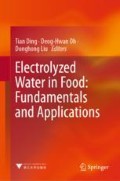Abstract
A promising area for the application of electrolyzed water is agriculture. Although the whole concept is relatively new, it has already been clearly shown that electrolyzed water can be suitable for use in multiple pre- and post-harvest applications. Plant irrigation using electrolyzed water has been successful for mitigation of pathogens as well as showing antibacterial effects against pathogens. Hence, electrolyzed water has the capability to be used as an agent for the mitigation of plant disease as well. Several plant diseases have been mitigated successfully so far using electrolyzed water. Furthermore, the technology fits well to be used for seed germination, product improvement, and yield increase too. Another relatively new application for electrolyzed water is in the production of flowers and foliage. There is still need for further evaluation of electrolyzed water for this purpose as well as testing it on more types of flower, but so far the technology has been useful as tested. The electrolyzed water technology is known for decades, but its application in agriculture is rather new. Combining the technology with other suitable methods for better efficiency is another possibility for future improvement in results as well as expanding the range of application. Some of these include but are not limited to ozonated and microbubbled water as well as a variety of other solutions currently in use. There is a great chance for the years to come for us to hear more news about electrolyzed water success in agriculture sector as an environmental and economical friendly sanitizer intervention for multiple uses.
Access this chapter
Tax calculation will be finalised at checkout
Purchases are for personal use only
References
Abbasi PA, Lazarovitz G (2006) Effect of acidic electrolyzed water on the viability of bacterial and fungal plant pathogens and on bacterial spot disease of tomato. Can J Microbiol 52:915–923
Al-Haq MI, Seo Y, Oshita S et al (2002) Disinfection effects of electrolyzed oxidizing water on suppressing fruit rot of pear caused by Botryosphaeria berengeriana. Food Res Int 35:657–664
Al-Haq MI, Sugiyama J, Isobe S (2005) Applications of electrolyzed water in agriculture and food industries. Food Sci Technol Res 11:135–150
Bonde MR, Nester SE, Khayat A et al (1999) Comparison of effects of acidic electrolyzed water and NaOCl on Tilletia indica teliospore germination. Plant Dis 83:627–632
Buck JW, Van Iersel MW, Oetting RD et al (2003) Evaluation of acidic electrolyzed water for phytotoxic symptoms on foliage and flowers of bedding plants. Crop Prot 22:73–77
Deng L, Huang C, Zhao S et al (2010) The effect of electrolyzed water on Chinese cabbage seeds germination. J Agric Mech Res 2:133–136
Fujiwara K, Doi R, Iimoto M et al (2000) Effects of spraying electrolyzed anode-side water and pH-available chlorine concentration-regulated water on the severity of powdery mildew infection and percentage of leaves with a leaf burn-like physiological disorder on cucumber leaves. Environ Control Biol 38:33–38
Fujiwara K, Fujii T, Park JS (2009) Comparison of foliar spray efficacy of electrolytically ozonated water and acidic electrolyzed oxidizing water for controlling powdery mildew infection on cucumber leaves. Ozone Sci Eng 31:10–14
Guentzel JL, Callan MA, Liang LK et al (2011) Evaluation of electrolyzed oxidizing water for phytotoxic effects and pre-harvest management of gray mold disease on strawberry plants. Crop Prot 30:1274–1279
Hirayama Y, Asano S, Watanabe K et al (2016) Control of Colletotrichum fructicola on strawberry with a foliar spray of neutral electrolyzed water through an overhead irrigation system. J Gen Plant Pathol 82:186–189
Hou M, Gao J, Deng L et al (2011) Effect of electrolyzed water on growth and development, nutritional quality of Chinese cabbage. Hubei Agric Sci 7(50):1342–1346
Huang YR, Hung YC, Hsu SY et al (2008) Application of electrolyzed water in the food industry. Food Control 19:329–345
Imran AM, Seo Y, Oshita S et al (2001) Fungicidal effectiveness of electrolyzed oxidizing water on postharvest brown rot of peach. HortScience 36:1310–1314
Jia GL, Shi JY, Song ZH et al (2015) Prevention of enzymatic browning of Chinese Yam (Dioscorea spp.) using electrolyzed oxidizing water. J Food Sci 80:C718–C728
Kim HJ, Feng H, Kushad MM et al (2006) Effects of ultrasound, irradiation, and acidic electrolyzed water on germination of alfalfa and broccoli seeds and Escherichia coli O157:H7. J Food Sci 71:168–173
Liu R, He X, Shi J et al (2013) The effect of electrolyzed water on decontamination, germination and aminobutyric acid accumulation of brown rice. Food Control 33:1–5
Mueller DS, Hung YC, Oetting RD et al (2003) Evaluation of electrolyzed oxidizing water for management of powdery mildew on gerbera daisy. Plant Dis 87:965–969
Pimentel D, Lack L, Zuniga R et al (2000) Environmental and economic costs of nonindigenous species in the United States. Bioscience 50:53–65
Rahman S, Khan I, Oh DH (2016) Electrolyzed water as a novel sanitizer in the food industry: current trends and future perspectives. Compr Rev Food Sci Food Saf 15:471–490
Rodríguez-Garcia O, González-Romero VM, Fernández-Escartín E (2011) Reduction of Salmonella enterica, Escherichia coli O157:H7, and Listeria monocytogenes with electrolyzed oxidizing water on inoculated hass avocados (Persea americana var. Hass). J Food Prot 74:1552–1557
Rui L, Jianxiong H, Haijie L et al (2011) Application of electrolyzed functional water on producing mung bean sprouts. Food Control 22:1311–1315
Author information
Authors and Affiliations
Corresponding author
Editor information
Editors and Affiliations
Rights and permissions
Copyright information
© 2019 Springer Nature Singapore Pte Ltd. and Zhejiang University Press, Hangzhou
About this chapter
Cite this chapter
Forghani, F. (2019). Application of Electrolyzed Water in Agriculture. In: Ding, T., Oh, DH., Liu, D. (eds) Electrolyzed Water in Food: Fundamentals and Applications. Springer, Singapore. https://doi.org/10.1007/978-981-13-3807-6_9
Download citation
DOI: https://doi.org/10.1007/978-981-13-3807-6_9
Published:
Publisher Name: Springer, Singapore
Print ISBN: 978-981-13-3806-9
Online ISBN: 978-981-13-3807-6
eBook Packages: Chemistry and Materials ScienceChemistry and Material Science (R0)

